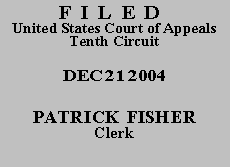

| GARY WARREN,
Petitioner-Appellant, v. JOHN ASHCROFT, United States Attorney General; ROBERT A. HOOD, Warden, United States Penitentiary ADM Maximum Florence, Respondents-Appellees. |
|
In this appeal we are required to decide whether 18 U.S.C. § 4206(d) (repealed) applies to all of the sentences imposed on petitioner between 1976 and 1989, including those imposed under 18 U.S.C. § 4208(a)(2) (repealed) and 18 U.S.C. § 4205(b)(2) (repealed). Agreeing with the district court that § 4206(d) does apply to all of his sentences, we affirm.
Petitioner's conviction history began in January 1976, when he was first convicted of bank robbery and ended in December 1988. Between those two dates, he amassed nine other convictions for bank robbery and escape. Petitioner, who is serving an aggregate term-in-effect of eighty-nine years based on these convictions, challenges the Bureau of Prison's calculation of his release date, now determined to be August 2031. Petitioner proceeds under 28 U.S.C. § 2241. We have jurisdiction under 28 U.S.C. § 2253(a),(1) and we review the denial of relief under § 2241 de novo. Gamble v. Calbone, 375 F.3d 1021, 1027 (10th Cir. 2004).
Section 4206(d) at the time pertinent to this appeal stated:
Any prisoner, serving a sentence of five years or longer, who is not earlier released under this section or any other applicable provision of applicable law, shall be released on parole after having served two-thirds of each consecutive term or terms, or after serving thirty years of each consecutive term or terms of more than forty-five years including any life term, whichever is earlier: Provided, however, That the Commission shall not release such prisoner if it determines that he has seriously or frequently violated institution rules and regulations or that there is a reasonable probability that he will commit any Federal, State, or local crime.
The provisions of this section apply only to offenses committed before November 1, 1987. Edmundson v. Turner, 954 F.2d 510, 512 n.2 (8th Cir. 1992).
Petitioner argues that the application of this statute to some of his consecutive sentences is violative of the principles of ex post facto and double jeopardy and further infringes on his rights to due process and equal protection. Without repeating the thorough analysis of the district court, we emphasize that the main principle driving this case is the fact that petitioner is not disadvantaged by the application of § 4206(d) to his sentences. Under the prior law in effect when his earlier sentences were imposed, parole determinations were discretionary with the parole board after acquiescence by the sentencing court. See § 4208(a)(2); § 4205(b)(2); see also Bowles v. United States, 49 Fed. Appx. 768, 769 (10th Cir. Oct. 8, 2002) (setting out text of § 4208(a)(2) and noting that it was recodified in 18 U.S.C. § 4205(b)(2)). Section 4206(b), in contrast, provides for mandatory parole, subject to some narrow exceptions. Because convicted persons have no right to parole before their sentences are fully served, Greenholtz v. Inmates of Nebraska Penal and Correctional Complex, 442 U.S. 1, 7 (1979), petitioner is actually benefitted by the application of this statute to his sentences because he has acquired a mandatory release date, something unavailable to him under prior law. Petitioner's arguments against the retroactive application of this statute to his case is unavailing because he has not been disadvantaged thereby. United States v. Orr, 68 F.3d 1247, 1252 (10th Cir. 1995).
As a final matter, respondents correctly argue that United States Attorney General John Ashcroft is improperly named as a respondent in this case. The district court noted this argument but did not address it. Because the attorney general is an improper party in a habeas appeal, Blango v. Thornburgh, 942 F.2d 1487, 1492 (10th Cir. 1991), Mr. Ashcroft is hereby DISMISSED from this appeal.
The judgment of the district court is AFFIRMED.
Entered for the Court
District Judge
*. This order and judgment is not binding precedent, except under the doctrines of law of the case, res judicata, and collateral estoppel. The court generally disfavors the citation of orders and judgments; nevertheless, an order and judgment may be cited under the terms and conditions of 10th Cir. R. 36.3.
**. The Honorable Clarence A. Brimmer, District Judge, United States District Court for the District of Wyoming, sitting by designation.
1. Contrary to respondents' contention, petitioner's notice of appeal was timely filed. Under Fed. R. App. P. 4(a)(1)(B), petitioner had sixty days in which to file his notice of appeal because an officer of the United States is a party to this appeal. The district court's order was entered on November 21, 2003. Petitioner's notice of appeal was file-stamped in the district court on January 14, 2004. R. Vol. I, tab 39.